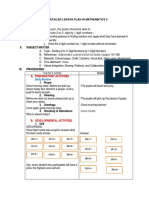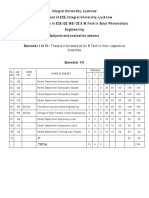Percents3 Theforestforthetrees
Percents3 Theforestforthetrees
Uploaded by
api-261894355Copyright:
Available Formats
Percents3 Theforestforthetrees
Percents3 Theforestforthetrees
Uploaded by
api-261894355Original Title
Copyright
Available Formats
Share this document
Did you find this document useful?
Is this content inappropriate?
Copyright:
Available Formats
Percents3 Theforestforthetrees
Percents3 Theforestforthetrees
Uploaded by
api-261894355Copyright:
Available Formats
The Forest 3
for the Trees
Determining the Part and the Whole in
Percent Problems
WARM UP LEARNING GOALS
Complete each equivalent • Use ratio and rate reasoning to solve percent problems
fraction. involving determining the part, the percent, and
the whole.
6 • Solve percent problems involving determining the part,
1. __ 5 _____
8 12 given the whole and the percent.
• Use ratio reasoning to estimate the value of the whole in
15 percent problems.
2. _____ 5 ___ • Solve percent problems involving determining the whole.
16 40
6
3. ___ 5 _____
15 10
You have learned how to use benchmarks to determine the percent of a number, but what
if you only know the part and the percent? How can you use your knowledge of percents to
determine the whole amount?
LESSON 3: The Forest for the Trees • M2-137
Getting Started
The Big Picture
When you study problems in terms of ratios, like percents, it is
important to think about the whole as well as the parts. The whole
is not always 100 or 1. And if the whole changes, this changes
the percent!
1. Consider the picture of triangles.
a. If the picture shown is 100% of the triangles, draw 50% of
the triangles.
b. If the picture shown is 30% of the triangles, draw 100% of
the triangles.
2. The given rectangle represents 25% of the whole figure.
a. Draw a rectangle that represents 50% of the whole figure.
M2-138 • TOPIC 2: Percents
b. Draw a rectangle that represents 75% of the whole figure.
c. Draw a rectangle that represents 100% of the whole figure.
3. The figure shown represents 75% of the whole figure.
a. Draw 25% of the figure.
b. Draw 100% of the figure.
LESSON 3: The Forest for the Trees • M2-139
AC T I V I T Y
Calculating a Percent
3.1 of a Quantity
Mr. Goodwin, the sixth grade math teacher, asked the class to
determine 25% of 44. Five different student responses are shown.
Kendra
25
Since 25% of 44 means multiplying __
100 times the
quantity, I used the fraction method.
25
____ 1
= _.
100 4
1
Then, I multiply _ • 44 = 11.
4
Hank
I like decimals much better than fractions.
25 = 0.25
___
100
0.25 • 44 = 11
Ryan
25% is easy to do in my head. 50% of 44 is 22.
1 1
25% is _ _
2 of 50%, so 25% of 44 is 2 of 22, which is equal to 11.
Simon
1
Since 25 is the same as _
4
, I just divided by four.
44 ÷ 4 = 11
Pamela
I prefer to use the benchmarks of 10% and 5%.
10% of 44 = 4.4.
20% is 2 . 10% = 2 . 4.4 = 8.8.
5% is half of 10% = 2.2.
Therefore, 20% + 5% = 8.8 + 2.2 = 11.0
M2-140 • TOPIC 2: Percents
1. Discuss each student method used.
A more efficient
method is one that
a. When is Kendra’s method most efficient to use?
requires fewer steps
or simpler steps to
determine an answer.
b. When is Hank’s method most efficient to use?
c. When is Ryan’s method most efficient to use?
d. When is Simon’s method most efficient to use?
e. When is Pamela’s method most efficient to use?
LESSON 3: The Forest for the Trees • M2-141
Ellen said, “All the methods are correct, and everyone got the correct
NOTES answer, but what if Mr. Goodwin gave us the problem 32% of 732?”
• Kendra said, “My fraction method is not as easy this time.”
8
32 ____
____ 5856
732 _____
? 5 5 234.24
100 1 25
25
• Hank said,
“32% 5 0.32
0.32 ? 732 5 234.24
My method is not any more difficult this time.”
• Ryan said, “I can still estimate . . . , but my answer will be close, not
1 1
exact. 32% is close to __3
and __
3
of 732 is 244.”
• Simon said, “I don’t have an easy fraction to use for 32%, so my
method works only for certain percents.”
• Pamela said, “I can still use my method.”
32% 5 10% 1 10% 1 10% 1 1% 1 1%
10% of 732 5 73.2 1% of 732 5 7.32
73.2(3) 5 219.6 7.32(2) 5 14.64
219.6 1 14.64 5 234.24
2. Which method do you prefer with this particular percent of a
quantity problem? Explain your thinking.
3. Determine the percent of each quantity.
a. 7% of 80 b. 15% of 55
c. 12% of 320 d. 8% of 300
M2-142 • TOPIC 2: Percents
e. 75% of 240 f. 37% of 120
NOTES
g. 150% of 27 h. 12.5% of 64
AC T I V I T Y
Determining the Whole with
3.2 a Double Number Line
Karla is in charge of designing a way to keep a running total of the
money raised by her homeroom for the Food Bank project. As of
today, her homeroom has raised $240, which is 60% of their goal.
WORKED EXAMPLE
Karla decided to use a double number line to record the money
raised and the percent of the goal raised.
0 $40 $240
Money Raised ($)
Percent of Goal
0 10% 60% 100%
The bottom number line represents the percent of the
homeroom goal. The top number line represents the amount
of money raised.
Karla’s homeroom has raised $240, which is 60% of the goal.
LESSON 3: The Forest for the Trees • M2-143
1. How did Karla determine the value that corresponds to 10%?
2. If $240 is 60% of the homeroom goal, what is 100% of the
goal? Explain how you determined the answer.
3. Which way of reporting is more informative: the amount of
money raised, or the percent of money raised? Explain your
thinking.
4. Complete each double number line to represent the goals of
the other sixth grade homerooms using the information from
the table. Write the equivalent dollar amount for each percent
shown.
Homeroom 6A 6B 6C 6D 6E 6F
60% of Goal 240 144 288 168
100% of Goal 400 360 120
M2-144 • TOPIC 2: Percents
a. Homeroom 6B
0% 10% 20% 30% 40% 50% 60% 70% 80% 90% 100%
b. Homeroom 6C
0% 10% 20% 30% 40% 50% 60% 70% 80% 90% 100%
c. Homeroom 6D
0% 10% 20% 30% 40% 50% 60% 70% 80% 90% 100%
d. Homeroom 6E
0% 10% 20% 30% 40% 50% 60% 70% 80% 90% 100%
e. Homeroom 6F
0% 10% 20% 30% 40% 50% 60% 70% 80% 90% 100%
LESSON 3: The Forest for the Trees • M2-145
AC T I V I T Y
3.3 Wholes in Proportions
You can use proportions to determine the whole in percent
problems.
WORKED EXAMPLE
Carlos is told that 65% of the students, or 78 students, prefer
pizza for lunch according to a recent survey. He wants to know
how many students were surveyed. He drew the model shown
to visualize the problem.
part whole
0 78 ?
Number
Percent
0% 65% 100%
He then wrote the proportion and determined that 120
students were surveyed.
Notice that 65 and
100 have a common part 78 65
______ __
= ____
factor of 5. whole ? 100
When analyzing a 45 36
ratio, always look for {___
65
____
{ 78
13 __
what the numerator {20{
100
= =
?
and denominator
have in common. 45 36
78
___ 65
= ___
120 100
1. How did Carlos determine the total number? Explain Carlos’
calculations.
M2-146 • TOPIC 2: Percents
Oscar NOTES
Instead of scaling down and then scaling up, it is more
efficient to scale up from the start. I can use the
structure of this proportion to determine the scale
factor.
Since 78 ÷ 65 5 1.2, I can scale up in one step by
multiplying by 1.2.
31.2
{
78
__ 65
?
{ 5 ___
100
31.2
100 3 1.2 5 120
78
___ 65
___
120 5 100
2. Use Oscar’s method to determine the unknown value.
45
____ 126
100
5 ____
?
3. Determine the whole in each situation. Explain your reasoning.
a. The best player on your school basketball team makes 60%
of her free throws. If she scored 90 points in a season on
free throws, which are worth one point each, how many free
throws did she attempt?
b. You got a quiz back and your teacher wrote 116, and 80% at
the top. How many points was the quiz worth?
LESSON 3: The Forest for the Trees • M2-147
c. Sandy made a 30% deposit on the purchase of a computer.
She gave the clerk $168. What is the price of the computer?
d. Your friends ate at a restaurant and left a $2.40 tip. They left
a 15% tip. What was the cost of their bill before the tip?
AC T I V I T Y
3.4 Wholes in Problems
An accountant is reviewing a store’s financial statements. But some
of the information is missing. All of the employee names, their bonus
percent, and bonus amounts should be listed in the table.
Employee Name Bonus Bonus Total Sales
Percent Amount
Kiesha 18% $540
Tonya 21% $3657.14
Ruth 15% $650
Mario 10% $3250
Joseph 23% $678
1. Help the accountant by determining each employee’s bonus
amount or total sales. Complete the table and show your work.
M2-148 • TOPIC 2: Percents
2. Gareth liked Hank’s method for calculating percents of a
number and thought it would work for calculating the whole.
He said that if you can multiply to determine the part of a
whole, maybe you can divide to determine the whole when you
know only the part.
He gave this example:
Percent Whole Part Unknown Value
20% of $1500 is 0.2 3 1500
20% of is $300 300 4 0.2
Is Gareth correct? Does this always work? Explain your thinking.
3. Determine each value.
a. 15 is 25% of what number? b. 15 is 30% of what number?
c. 45 is 75% of what number? d. 16 is 20% of what number?
e. 36 is 40% of what number? f. 6 is 15% of what number?
g. 27 is 30% of what number?
LESSON 3: The Forest for the Trees • M2-149
4. A department store recently had a big sale where the prices of
items were marked 25% off of the regular price. Now that the
25% OFF the sale is over, Tremain needs to mark each of the items back up
regular price to its original price. The items and their sale prices are listed in
means 75% the table. Help Tremain complete the table.
OF the regular
price!
Item Sale Price Original Price
shirt $24.00
pants $36.00
sweater $59.95
suit $299.00
sports coat $159.95
5. The department store realizes it isn’t making enough money.
The store manager decides to mark up prices by 20%.
Complete the table with the new price for each item.
Item Original Price New Price
shirts $22.00
pants $29.00
shoes $65.00
jackets $50.00
M2-150 • TOPIC 2: Percents
6. The department store orders toasters from a company that
produces three different models of toasters. The company
has found that the percent of each shipment that is defective
differs by model. Model A’s defect rate is 2.5%, Model B’s
defect rate is 1.75%, and Model C’s defect rate is 3.2%.
On a particular shipment, the company forgets to mark the
total number shipped of each model. You only know that you
received 5 defective Model A toasters, 7 defective Model B
toasters, and 16 defective Model C toasters. How many of each
model were shipped?
AC T I V I T Y
3.5 Wholes in Geometry
You can apply what you have learned about wholes, percents, and
ratio reasoning to solve percent problems in geometry too.
1. Corinne’s new dog pen is a rectangular pen that measures
12 yards by 4 yards. She reduced the area of her old
rectangular dog pen by 60% after adopting out 6 puppies.
List some possible dimensions of Corinne’s old dog pen.
Explain your reasoning.
LESSON 3: The Forest for the Trees • M2-151
2. The tank shown is 75% full of water.
a. What is the height of the tank? Explain how you solved the
problem.
5.5 cm
7.5 cm
18 cm
b. Suppose the outside of the tank is covered with paper only
up to the water level. What percent of the total surface area
of the tank would be covered? Round to the nearest whole
percent. Be sure to include the top of the tank in the total.
M2-152 • TOPIC 2: Percents
3. Linda wants to make doggy treats for 3 in.
her dog John Henry. The center 20% 4
of each treat will be peanut butter.
The rest will be a biscuit made from
a mixture of wheat flour, eggs, and 1 in.
2
mashed bananas. What is the total
volume of the doggy treat, including
the peanut butter? What is the volume 3 in.
4
of just the biscuit?
4. The area of Parallelogram A is 25% of the area of
Parallelogram B. What is the height of Parallelogram B?
Show your work.
7.5 cm
18 cm 16 cm
Parallelogram A Parallelogram B
LESSON 3: The Forest for the Trees • M2-153
NOTES
TALK the TALK
Try and Try Again
For each question, demonstrate two different ways to determine
the answer.
1. Leah’s goal is to score a 90% on the upcoming science test.
If there are 40 questions on the test, how many does Leah
need to answer correctly?
2. Today, Antonio made 40% of the burritos sold during
the lunch rush at work. If he made 28 burritos during this
time, what is the total number of burritos made during
the lunch rush?
Plan a presentation of your 2 solutions. Talk about how they are
the same and how they’re different.
M2-154 • TOPIC 2: Percents
Assignment
Write Remember
Compare different ways to Percent problems often have a part, a percent, and a whole.
determine the whole in a percent When you know the part and the percent, you can use a variety of
problem: using double number strategies to determine the whole.
lines, writing a proportion, and
using division.
Practice
1. A manager at the department store keeps track of “points” for each employee. Employees earn points
by being on time for work and for keeping the department neat. On a particular day, he gives “smile”
points for each time an employee smiles at a customer. He recorded the smile points that each employee
received, along with the total points for that employee. He had a problem with his computer, though, and
some of the entries were deleted. Help the manager complete the table.
Employee Smile Percent of Total
Name Points Total Points Points
Garrett 15 5%
Ricardo 8% 325
Brent 6 2%
Lin 21 6%
Danielle 45 12%
2. The Music Department of a department store sold 12 jazz CDs last month. Jazz sales during that month
made up 2% of the Music Department’s total sales.
a. Determine the number of CDs that the store sold during that month.
b. Suppose that the store sells 14 jazz CDs during the next month and the percent of sales from jazz CDs
is still 2%. What is the total number of CDs that the store will sell?
3. Calculate each value.
a. 12 is 20% of what number? b. 28 is 35% of what number?
c. 84 is 42% of what number? d. 32 is 80% of what number?
e. 35% of 60 is what number? f. 25% of 132 is what number?
g. 5% of 40 is what number? h. 15% of 80 is what number?
LESSON 3: The Forest for the Trees • M2-155
Stretch
Bob ate at a restaurant one night with 2 friends. The cost of his meal was 10% of the cost of the 3 meals
before the tip. Four receipts from the restaurant that night are shown. Some of the groups gave an 18% tip
and some gave a 15% tip, but you’re not sure which is which.
1. Which guest was Bob, and where was he sitting?
TABLE 1 TABLE 2
Guest 1: Guest 1: $38.45
Guest 2: $18.00 Guest 2: $34.81
Guest 3: $12.00 Guest 3:
Tip: $4.96 Tip: $14.65
TABLE 3 TABLE 4
Guest 1: $18.22 Guest 1: $35.11
Guest 2: Guest 2: $35.05
Guest 3: $41.00 Guest 3:
Tip: $11.74 Tip: $15.90
Review
1. Jai has a 28% free throw rate in basketball. That means when he shoots a free throw he makes a basket
28% of the time. Jai shoots 120 free throws in a season. How many baskets is he likely to make? Use
benchmark percents of 1% and 10% to help you determine the answer.
a. What is 1% of 120? b. What is 10% of 120?
c. What is 20% of 120? d. What is 8% of 120?
2. In Tampa, Florida, the sun shines about 66% of the year. About how many days does the sun shine in Tampa?
3. Bill is painting his room a certain shade of green. The paint is a mixture of 3 parts blue paint to 2 parts yellow
paint. To get the correct shade of green, how much yellow paint should he add to 6 quarts of blue paint?
4. LaShaya answered 9 out of 10 questions correctly on her math quiz. Her twin sister LaTeisha answered 22 out of
25 questions correctly on her math test. Did they have the same ratio of correct problems to total problems?
5. Determine each product.
a. 0.6 3 95 b. 210 3 0.75
M2-156 • TOPIC 2: Percents
You might also like
- For Dummies Collection - 978 EbooksDocument12 pagesFor Dummies Collection - 978 EbooksAdiya Ariagiaberete Giva14% (14)
- Lesson 2 Bar None Equations UnitDocument12 pagesLesson 2 Bar None Equations Unitapi-261894355No ratings yet
- Quality Management FootwearDocument108 pagesQuality Management FootwearSundarapandiyan Sundaramoorthy100% (7)
- Lesson 1 First Among Equals Equations UnitDocument20 pagesLesson 1 First Among Equals Equations Unitapi-2618943550% (1)
- Numerical Reasoning Practice TestDocument14 pagesNumerical Reasoning Practice TestlordaiztrandNo ratings yet
- Lesson 3 Play It in Reverse Equations UnitDocument16 pagesLesson 3 Play It in Reverse Equations Unitapi-261894355No ratings yet
- Coordinate Plane l2 Its A Bird Its A Plane SeDocument14 pagesCoordinate Plane l2 Its A Bird Its A Plane Seapi-261894355No ratings yet
- BiographiesDocument6 pagesBiographiesRakhunath RamankuttyNo ratings yet
- Animal Law: Human Duties or Animal Rights?: October 2020Document47 pagesAnimal Law: Human Duties or Animal Rights?: October 2020Gabriel FloreaNo ratings yet
- Daily Lesson PlanDocument8 pagesDaily Lesson PlanMohdSufianNo ratings yet
- Learning Activity Sheet No. 1Document5 pagesLearning Activity Sheet No. 1ronald100% (1)
- Problem Solving Using FormulaDocument12 pagesProblem Solving Using FormulaAisalie F. BoloNo ratings yet
- Cot Mathematics 5Document2 pagesCot Mathematics 5irec100% (4)
- Math6 - Q2 - WEEK 2 - V2 Finally Approved For Printing 4Document10 pagesMath6 - Q2 - WEEK 2 - V2 Finally Approved For Printing 4Mariel SalazarNo ratings yet
- Converting Fractions To PercentsDocument10 pagesConverting Fractions To Percentshlmvuong123No ratings yet
- Cot - DLP - Mathematics 5 by Teacher Filpa D. AroDocument2 pagesCot - DLP - Mathematics 5 by Teacher Filpa D. AroAriel PunzalanNo ratings yet
- Module5 Mathematics6 Q2 W3 PERCENT-RATE-BASEDocument13 pagesModule5 Mathematics6 Q2 W3 PERCENT-RATE-BASEJohn Paul TaylanNo ratings yet
- First Form Numeracy Module 6Document12 pagesFirst Form Numeracy Module 6Chet AckNo ratings yet
- Math DLP G6 Q1 W8Document8 pagesMath DLP G6 Q1 W8Raquel FamorcaNo ratings yet
- Lesson Plan-KiahaVictorianoDocument6 pagesLesson Plan-KiahaVictorianoVICTORIANO PAQUIULNo ratings yet
- Module 2Document6 pagesModule 2Luigi AlmohedaNo ratings yet
- Pre Service Teachers Evaluation SheetDocument4 pagesPre Service Teachers Evaluation SheetMark Adrian Borja IVNo ratings yet
- m5q3w2 Las 4Document5 pagesm5q3w2 Las 4ronaldNo ratings yet
- Cot - DLP - Mathematics 5 by Teacher Filpa D. AroDocument3 pagesCot - DLP - Mathematics 5 by Teacher Filpa D. AroMyrrh Balanay FloridaNo ratings yet
- Beed2c G2demonstratorDocument6 pagesBeed2c G2demonstratorJarisa KilamNo ratings yet
- Grade - 8 - Maths - Worksheet - Term 3Document50 pagesGrade - 8 - Maths - Worksheet - Term 3dheeraj yadavNo ratings yet
- Ratio and ProportionDocument53 pagesRatio and ProportionAbewenico LabajoNo ratings yet
- Math10 Q4 Week 1 Hybrid Version2Document15 pagesMath10 Q4 Week 1 Hybrid Version2francisjoycebelmonteNo ratings yet
- Grade - 8 - Maths - Worksheet - Term 3 PDFDocument65 pagesGrade - 8 - Maths - Worksheet - Term 3 PDFDheeraj Yadav100% (1)
- DLP Day 2Document4 pagesDLP Day 2Aisley Mae EspinarNo ratings yet
- 3 Math5Q1Week7Document25 pages3 Math5Q1Week7Sophia Pauline HernandezNo ratings yet
- Math 5 DLPDocument2 pagesMath 5 DLPMaGrace Pancho Magana100% (3)
- Finding The Percentage When The Rate & BaseDocument21 pagesFinding The Percentage When The Rate & BaseANGEL100% (3)
- Pre Service Teachers Evaluation SheetDocument3 pagesPre Service Teachers Evaluation SheetNoe JanabanNo ratings yet
- Cpe106 Lesson2Document9 pagesCpe106 Lesson2saphinanaddinNo ratings yet
- Undergraduate Assessment Test Study Guide: October 2019Document20 pagesUndergraduate Assessment Test Study Guide: October 2019Rosa AdamesNo ratings yet
- 4a's Lesson PlanDocument7 pages4a's Lesson PlanLhera Mae AquinoNo ratings yet
- MATH 6 - Q1 - Mod7Document29 pagesMATH 6 - Q1 - Mod7Jermer Tabones100% (6)
- Diagnostic Test in Math 5 Table of Specifications Learning Competency No. of Items Place Ment Percen TageDocument6 pagesDiagnostic Test in Math 5 Table of Specifications Learning Competency No. of Items Place Ment Percen TageJohn Paul Dela PeñaNo ratings yet
- Percentages: Chapter OverviewDocument10 pagesPercentages: Chapter OverviewmahmoodanyshaNo ratings yet
- TLE Lesson Plan Template Semi-DetailedDocument3 pagesTLE Lesson Plan Template Semi-Detailedmarvin cayNo ratings yet
- Numerical Reasoning Practice TestDocument9 pagesNumerical Reasoning Practice TestJeselica Anne Marie CastroNo ratings yet
- Percents Are Ratios - 6Document14 pagesPercents Are Ratios - 6ahee_1No ratings yet
- Midtermbm11lm#3 DecimalsDocument5 pagesMidtermbm11lm#3 DecimalsjulianneNo ratings yet
- Business Math 1-7 ModulesDocument149 pagesBusiness Math 1-7 Modulesangelgabito332No ratings yet
- G6 DLL Q1 Week 9Document17 pagesG6 DLL Q1 Week 9Hilda Tactay-MapanaoNo ratings yet
- Math Grade10 Quarter4 Week3 Module3Document4 pagesMath Grade10 Quarter4 Week3 Module3professor jaxNo ratings yet
- Bohol Math6 Q1 PLP6Day1 v.01Document3 pagesBohol Math6 Q1 PLP6Day1 v.01Ellaiza Yinx OdercNo ratings yet
- Unit 5 Multiplication and DivisionDocument13 pagesUnit 5 Multiplication and DivisionRicha jaiswalNo ratings yet
- INFERENCIAL ACTIVITIES MAED UpdatedDocument14 pagesINFERENCIAL ACTIVITIES MAED UpdatedMel Rose CabreraNo ratings yet
- 8 Apr P5 BookletDocument24 pages8 Apr P5 BookletEthan ChuangNo ratings yet
- 01 Teaching NotesDocument7 pages01 Teaching Notesfatcat7294.01No ratings yet
- Ratio and Proportion: Chapter OverviewDocument11 pagesRatio and Proportion: Chapter OverviewmahmoodanyshaNo ratings yet
- 11 testDocument2 pages11 testsyum amareNo ratings yet
- Key Concepts: Ratios and RatesDocument4 pagesKey Concepts: Ratios and RatesAngellaNo ratings yet
- Puzzles For Practice - Fractions and DecimalsDocument48 pagesPuzzles For Practice - Fractions and Decimalsapi-28303658380% (10)
- Bus Math Q1 W1 D4&5Document6 pagesBus Math Q1 W1 D4&5Baems AmborNo ratings yet
- Assignment 1Document2 pagesAssignment 1yohanaameliaNo ratings yet
- Answer Quiz Chapter 4Document12 pagesAnswer Quiz Chapter 4FlaMe Welcome ツNo ratings yet
- Relationship of Percent and RatioDocument6 pagesRelationship of Percent and RatioLykha Mea Delgado BacalsoNo ratings yet
- Mathematics Grade 5: Learning Activity Sheet Lesson 2 Quarter 3Document5 pagesMathematics Grade 5: Learning Activity Sheet Lesson 2 Quarter 3CARICRIS MARATANo ratings yet
- Measures of PositionDocument17 pagesMeasures of PositionRechelle MollanidaNo ratings yet
- Area Perimeter Lesson PlanDocument3 pagesArea Perimeter Lesson Planapi-425063439No ratings yet
- Phase 1 Demo PDFDocument4 pagesPhase 1 Demo PDFSa Res YbanezNo ratings yet
- Let's Review Regents: Algebra II Revised EditionFrom EverandLet's Review Regents: Algebra II Revised EditionRating: 5 out of 5 stars5/5 (1)
- Math Practice Simplified: Money & Measurement (Book K): Applying Skills to Problems Dealing with Money and MeasurementFrom EverandMath Practice Simplified: Money & Measurement (Book K): Applying Skills to Problems Dealing with Money and MeasurementNo ratings yet
- Lesson 4 Getting Real Equations UnitDocument10 pagesLesson 4 Getting Real Equations Unitapi-2618943550% (1)
- CL Topic 1 Expressions Skills Practice SeDocument20 pagesCL Topic 1 Expressions Skills Practice Seapi-261894355No ratings yet
- Ex. SNBT 1 Literasi Dalam Bahasa InggrisDocument6 pagesEx. SNBT 1 Literasi Dalam Bahasa InggrisNisma WidyaNo ratings yet
- Dual DegreeDocument19 pagesDual DegreekhananuNo ratings yet
- A Rice SandwichDocument14 pagesA Rice SandwichÁlvaroNo ratings yet
- Affidavit Notarized UndertakingDocument3 pagesAffidavit Notarized UndertakingVenkataramanareddy SuraNo ratings yet
- 0 Switchword List Supplement 2014Document15 pages0 Switchword List Supplement 2014Soumya Pandey100% (4)
- Introduction To The Gnostic Shamanism of LightDocument4 pagesIntroduction To The Gnostic Shamanism of LightAdamjollygreen100% (1)
- College of Physicians and Surgeons Pakistan: Diagnostic RadiologyDocument13 pagesCollege of Physicians and Surgeons Pakistan: Diagnostic Radiologymohammad sohaibNo ratings yet
- Indy Oil Field Development Plan PDFDocument139 pagesIndy Oil Field Development Plan PDFMohamed Yousry100% (1)
- Catalogo LASADocument10 pagesCatalogo LASAsandra cuestaNo ratings yet
- Problem Solving: Lingua House Lingua HouseDocument7 pagesProblem Solving: Lingua House Lingua HouseLauravictNo ratings yet
- Gender, Religion & CasteDocument5 pagesGender, Religion & CasteSocialscience4u.blogspot.com100% (8)
- Math 4THDocument8 pagesMath 4THDarnell Raymundo CapurasNo ratings yet
- 98 367 Demo - 2Document26 pages98 367 Demo - 2cooler masterNo ratings yet
- Nutrition in The Critically Ill PatientDocument13 pagesNutrition in The Critically Ill PatientnainazahraNo ratings yet
- National Income MCQsDocument6 pagesNational Income MCQsZeeshan Afzal100% (1)
- Kinds of MotionsDocument2 pagesKinds of MotionsCzar Ian AgbayaniNo ratings yet
- Arsi University College of Behavioral and Educational Science General Psychology Assignment For 2 Year Afan Oromo Student (20%)Document5 pagesArsi University College of Behavioral and Educational Science General Psychology Assignment For 2 Year Afan Oromo Student (20%)Efrem WondaleNo ratings yet
- Carrier Oils Chart PDFDocument4 pagesCarrier Oils Chart PDFFanfare FNo ratings yet
- Diary ANDRADEDocument3 pagesDiary ANDRADEFernanda Guillen SalazarNo ratings yet
- Closing The Achievement Gap With Curriculum Enrichment and DifferentiationDocument30 pagesClosing The Achievement Gap With Curriculum Enrichment and DifferentiationSANDRA MENXUEIRONo ratings yet
- Meningeal Spaces (Banovac)Document2 pagesMeningeal Spaces (Banovac)CarlaNo ratings yet
- 7-8 EthicsDocument24 pages7-8 EthicsRyan Benedict Buenaventura TillamanNo ratings yet
- NUKATHOTI RAKESH ROSHAN Hyderabad - Secunderabad 4.00 YrsDocument4 pagesNUKATHOTI RAKESH ROSHAN Hyderabad - Secunderabad 4.00 YrsSitareddy ReddyNo ratings yet
- Notice Reply of Pawan Bothra (Final)Document4 pagesNotice Reply of Pawan Bothra (Final)Rittik SarkarNo ratings yet
- United States Court of Appeals, Fourth CircuitDocument12 pagesUnited States Court of Appeals, Fourth CircuitScribd Government DocsNo ratings yet
- FARRINGTON - Longitudinal Research On CrimeDocument60 pagesFARRINGTON - Longitudinal Research On CrimeEduardo Matos de AlencarNo ratings yet































































































